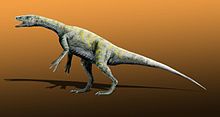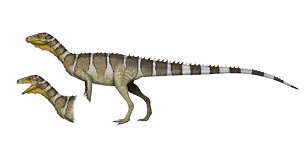
Panphagia, hailing from the Late Triassic period, was first introduced to the world in 2012. Its name, derived from Greek roots, translates to "eats everything" reflecting its presumed herbivorous diet and highlighting its central role in the ancient ecosystem.
With a relatively modest size, Panphagia stood on its hind legs, featuring a long neck and tail. Its skeletal structure reveals a mosaic of anatomical features, offering clues about its evolutionary lineage and its place in the tree of life.
| Name: | Panphagia dinosaurs |
| Size: | Around length:1.2 meters (4 feet); weight:10-15 kilograms (22-33 pounds). |
| Main Facts: | Panphagia represents an early herbivorous dinosaur, illustrating the shift from carnivory to plant-based diet in dinosaur evolution. |
Panphagia's position as one of the earliest known herbivorous dinosaurs carries significant evolutionary implications. Its presence highlights the emergence of herbivory as a successful survival strategy, paving the way for the diverse array of plant-eating dinosaurs that would follow.

As a herbivore, Panphagia played a crucial role in shaping the composition of its ecosystem. Its interactions with plants, other herbivores, and potential predators contributed to the delicate balance of life during the Late Triassic.
Comparing Panphagia with other early dinosaurs, both herbivorous and carnivorous, provides a glimpse into the complexity of the Late Triassic ecosystem. These comparisons offer insights into niche partitioning, predator-prey dynamics, and the coexistence of different dinosaur groups.
Studying Panphagia's fossils and comparing them with those from other regions contributes to our understanding of continental connections during the Late Triassic. It offers clues about the distribution of dinosaurs across ancient landmasses.
Panphagia , a significant figure from the Late Triassic, represents one of the earliest known herbivorous dinosaurs. Its name, meaning "eats everything", alludes to its transition from carnivory to herbivory. With a bipedal stance, long neck, and specialized teeth for plant consumption, Panphagia offers a glimpse into the early evolution of herbivorous tendencies. Fossils discovered in South America provide insights into the lush landscapes it inhabited, contributing to our understanding of ancient ecosystems and the emergence of diverse dinosaur lineages. As an emblem of adaptation and survival, Panphagia enriches our understanding of the intricate journey that paved the way for the magnificent diversity of dinosaurs that would follow in its footsteps.
Comparing Panphagia with other early dinosaurs sheds light on the transition from carnivory to herbivory. Its specialized teeth for plant consumption offer a pivotal glimpse into the development of herbivorous adaptations and the diversification of dietary strategies.
Contrasting Panphagia's dental structure with that of other dinosaurs reveals variations in tooth shape, arrangement, and wear patterns. Such comparisons help decipher the types of plants it consumed and its potential ecological niche within the ecosystem.
Comparative studies with other Late Triassic dinosaurs elucidate dietary niches and resource utilization. Contrasts with contemporary herbivores and carnivores provide insights into competition, trophic relationships, and the role of Panphagia in the ecosystem.
Comparing Panphagia's bipedal stance and locomotion with other dinosaurs showcases the diversity of movement strategies among early dinosaur groups. Such comparisons contribute to our understanding of locomotor adaptations and functional morphology.
Panphagia's position as one of the earliest known herbivorous dinosaurs offers glimpses into the diversification of dinosaur lineages during the Late Triassic. Comparing its traits with those of other contemporaneous dinosaurs contributes to our understanding of the broader evolutionary landscape.
Studying Panphagia alongside other dinosaurs found in Late Triassic South America helps reconstruct the paleoenvironment, including plant communities, climate, and ecosystem structure. These comparisons provide a comprehensive view of the ancient world.
Comparative analyses of Panphagia's anatomy and traits with other early dinosaurs offer insights into its evolutionary relationships and potential ancestors or descendants. Such comparisons contribute to refining the dinosaur family tree.
Comparing Panphagia's interactions with other herbivores, such as synapsids, and potential predators, such as early theropods, unveils predator-prey dynamics and coexistence strategies within the ecosystem.
Comparing Panphagia's presence in South America with other dinosaurs from different regions provides information about dinosaur distribution, migration patterns, and potential continental connections during the Late Triassic
The comparative study of Panphagia and other dinosaurs fuels ongoing research and exploration, driving the advancement of knowledge about early dinosaur evolution, ecology, and the intricate web of life that existed millions of years ago.